I’m a bit of a nutrition fanatic – and for a good reason. When I eat crappy food, I feel like crap. So, I simply can’t get on board with backpackers who eat Fritos (one of the most calorie-dense backpacking foods) for lunch on the trail. Backpacking nutrition matters – and there is a lot more to nutrition than just calories!
I don’t think that backpackers need to obsess too much about nutrition though. If there is ever a time that it’s “okay” to eat junk food, it is while you are trekking for hours with a heavy pack on your back! But, if you want to have more energy, less inflammation, fewer muscle cramps, and recover faster, you should at least know the basics of backpacking nutrition.
Jump To:
*Guess what? I wrote a book. It’s got over 50 healthy backpacking recipes plus ton of info on how to plan backpacking meals. Learn more here.
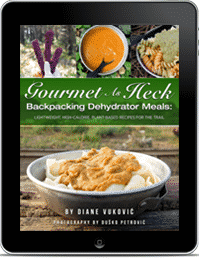
1. Calories
A calorie is a unit of measurement. Technically, a calorie is the amount of energy needed to raise 1 gram of water by 1 degree Celsius. However, we generally refer to calories as a way to say how much energy a food contains.
Macronutrients (carbs, fats, and proteins) each provide calories:
- Carbs: 4 calories per gram
- Fats: 9 calories per gram
- Proteins: 4 calories per gram
Because fats have the most calories per gram, they are considered the most calorie-dense foods. Those Fritos which have so many calories? It’s because they are loaded with corn oil.
*Not sure how many calories you need while backpacking? Use this calculator.
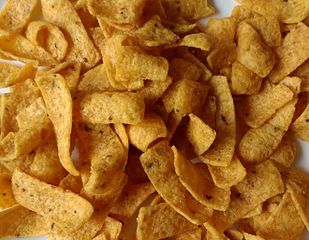
Fritos are high calorie but not necessarily a good backpacking food!
Problems with Calorie Counts
Calories in food are measured using something called a bomb calorimeter. Basically, a food is put into a chamber where it is surrounded by water. The food is then ignited and the calorimeter measures how much the temperature of the water increases.
The issue with these calories counts is that our bodies don’t burn up food! The last I checked, I didn’t have a literal furnace inside my stomach!
Many of the foods we eat end up not getting absorbed at all (in other words, they just get pooped out – see the section on nuts below).
In addition to this, our bodies burn certain types of calories differently – like how we blow through calories from refined sugars quickly but get more sustained energy from complex carbs. This is why you can eat tons of calories from refined sugar but still end up feeling exhausted on the trail. (1)
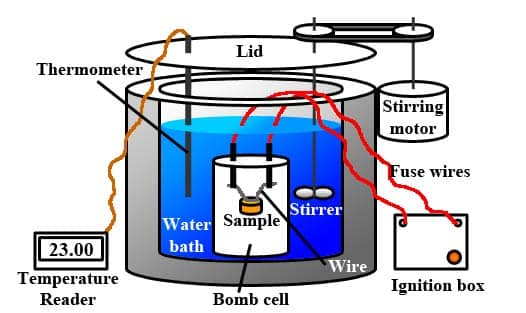
This is what a bomb calorimeter looks like. Obviously, our digestive systems don’t work this way! Image credit: Lisdavid89, Wiki
Nuts: Not Really a Calorie-Dense Food

Nuts are a perfect example of how inaccurate calorie counts on nutrition labels are.
If you’ve ever pooped in the woods after eating a lot of trail mix, then you are aware that many of those nuts are not getting absorbed by your body (and that you surprisingly don’t chew your food as much as you thought 😉 ).
A lot of research has been done on the actual calorie count of nuts. For example, the studies reported on here, here, and here) have found that almonds and walnuts contain around 20-32% fewer calories than the label indicates!!!!
Does this mean that nuts are a bad backpacking food, in terms of calories at least?
Not necessarily. Studies have found that chewing nuts – I mean really chewing them – results in more calories and fat being absorbed by the body. Likewise, studies have found that virtually all of the calories from nut butters are absorbed.
Basically, the more ground-up the nuts are (peanut butter vs. peanuts) and how much you pre-chew nuts drastically affects how well your body can absorb the food.
The bottom line? To get maximum calories from your nuts/seeds on the trail:
- Chew them thoroughly!
- Or bring nut butters instead of whole nuts
*I make really badass sauces out of blended nuts. Then I dehydrate these and take them backpacking. The cashew-tomato sauce below, for example, has 163 calories per ounce! It’s healthy, lightweight, and very calorie-dense. You can get the recipe (and many more healthy backpacking recipes) in my eBook. Get my book here.
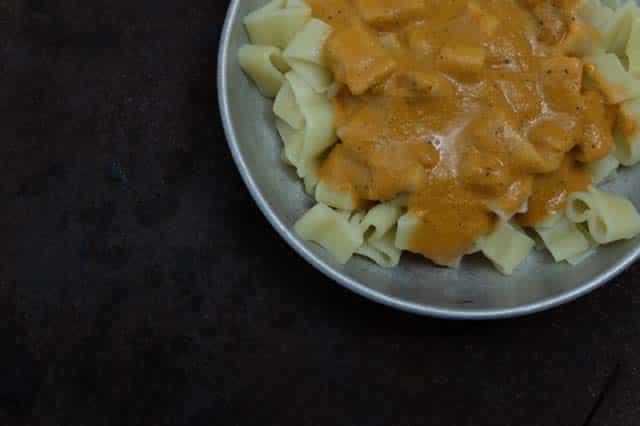
This nut-based sauce has 163 calories/oz when dehydrated. Get the recipe in my eBook.
2. Macronutrients
There are three main nutrients (called macronutrients because they are required by the body in large amounts). These are carbohydrates, fats, and proteins.
By contrast, micronutrients are the many types of vitamins and minerals that our bodies need. Micronutrients are not only important for maintaining healthy body functions, but are critical to digesting micronutrients. We’ll get into micronutrients a bit later.
Carbohydrates
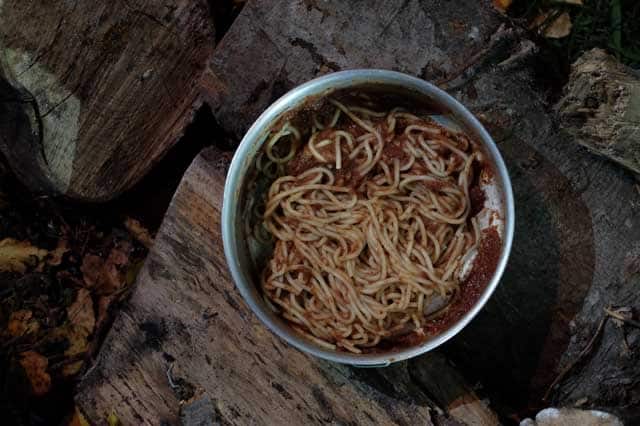
When we eat carbohydrates (such as pasta, rice, or candies), our bodies convert them into glucose – a form of sugar that the body uses for energy. Because there is only so much sugar that can be in your blood at once; any extra glucose gets turned into glycogen.
Glycogen gets stored in the liver and muscles. If you want to avoid hitting a wall and muscle wasting, you need to have adequate amounts of glycogen in both your liver and muscles.
Glycogen in the Liver
Some glycogen gets stored in the liver. This glycogen can be turned back into glucose to use as fuel. It is a great source of energy. During moderate-intensity exercises (like backpacking), about 55-60% of energy comes from glycogen. When doing high-intensity exercises (like running a marathon), over 85% of energy can come from glycogen. (2)
The liver can only store about 90-110 grams of glycogen, which is the equivalent of 3-4 hours of normal activity.
When you run out of glucose and glycogen, the body will turn to fat for fuel. This how low-carb diets work: by forcing your body to burn fat.
What happens if your body also runs out of fat? The body will start to digest proteins for energy. That often means breaking down your muscle tissue – which is why thru-hikers can end up with their muscles wasting away!
This is why carbs are so important for backpacking. You need to eat enough carbs to give your body immediate energy (in the form of glucose) and that you have extra glucose in your blood so it turns into glycogen in your liver.
Don’t eat enough carbs and you will bonk, or “hit a wall”! Continue to deprive yourself of carbs and your muscles will start wasting away.
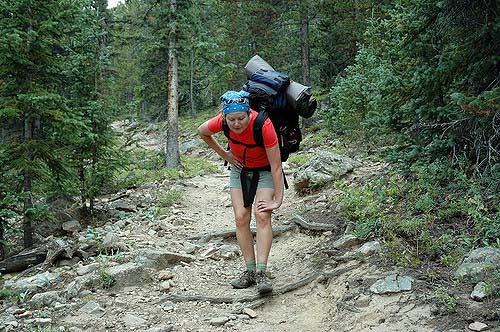
This is what hitting a wall looks like! Image credit:”Feeling Tired” (CC BY-NC-ND 2.0) by Matt Crest
Glycogen in the Muscles
Liver glycogen is important, but most of the glycogen gets stored in the muscles. This glycogen can’t be turned back into glucose; it is what your muscles use for fuel.
Exercising will cause glycogen to be depleted from your muscles fairly quickly. Numerous studies have shown that reduced-carb diets lead to poor performance, fatigue, and everything else that backpackers consider “hitting a wall.”
It is really important that you eat some carbs after you finish hiking for the day. Since you will be inactive during this time, the carbs don’t get used up right away and can be turned into glycogen to replenish your muscles.
How Many Carbohydrates?
For endurance athletes, it is generally recommended that you consume 4-5 grams of carbs per pound of body weight.
For a 150lb man, for example, that would mean about 675 carbs – or 2700 calories from carbs.
During more intense exercise—such as when hiking up a difficult slope — you might need about 90 grams of carbs per hour. (5, 6, 7)
In recap:
- Carbohydrates get converted into glucose to be used as energy
- Excess glucose gets turned into glycogen, which is stored in the liver and muscles
- When glucose and liver glycogen run out, the body uses fat for fuel. Then it turns to protein – including muscle tissue – for fuel
- When glycogen in muscles runs out, you will hit a wall!
- You need to eat carbs while hiking and when you finish hiking to keep glycogen stores full.
Fats
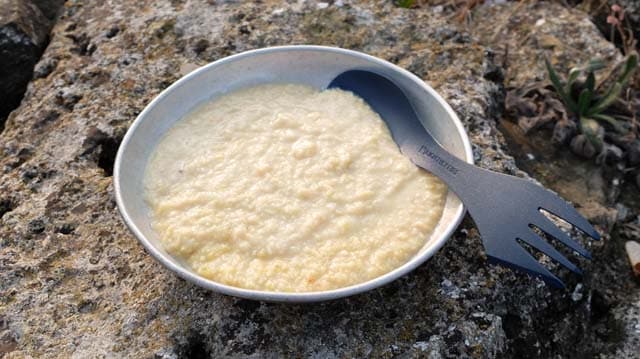
This dehydrator corn chowder is made with coconut milk so it is loaded with fat. Get the recipe in my eBook.
Fats contain 9 calories per gram compared to just 4 calories/gram with carbs. This makes them incredibly calorie dense and a good source of energy.
When we eat fat, it is broken down into fatty acids. These can be transported to the muscles to use as fuel. The muscles still prefer to use glycogen for fuel. However, when there isn’t’ enough glycogen, muscles can go off of fat.
This is why some thru-hikers justify packing lots of fatty foods. They say that the body can be “trained” to burn more fat for fuel instead of carbs. However, there isn’t any research (that I’m aware of) which actually backs this up.
It can be tempting to take a lot of fatty foods backpacking because of how calorie-dense they are. However, this would be a mistake.
Some issues with relying on fat for energy are:
- It takes a long time to break down fat (up to 6 hours).
- Once your breaks down the fat, it takes even more time to get to your muscles.
- The body requires oxygen to break down fat. This means the body has trouble breaking down fat during intense exercise (because your body is using more oxygen) and at higher altitudes.
This is why it is a bad idea to eat very fatty foods while backpacking. You could end up with stomach aches, nausea, or diarrhea. You should eat your fatty foods long before or after you hit the trail. (8)
Research done by the military backs this up. One military study found that, “It seems a matter of indifference to the muscles whether they receive their energy from carbohydrate or from fat.” However, muscular work is done with less effort when there is a plentiful supply of carbohydrates.
In particular, the studies have found that load-bearing work (much like hiking with a heavy pack!) are perceived as more difficult when there’s a carb deficiency. Thus, the military has recommended that soldiers on deployment get more carbohydrates in their rations.
In summary: You need to balance carbs and fats! Be careful not to overly-emphasize one or the other. Avoid consuming too many fats while hiking – especially during very strenuous parts of the hike. Consume them long before you hit the trail or when you’re done hiking for the day. (9)
Protein
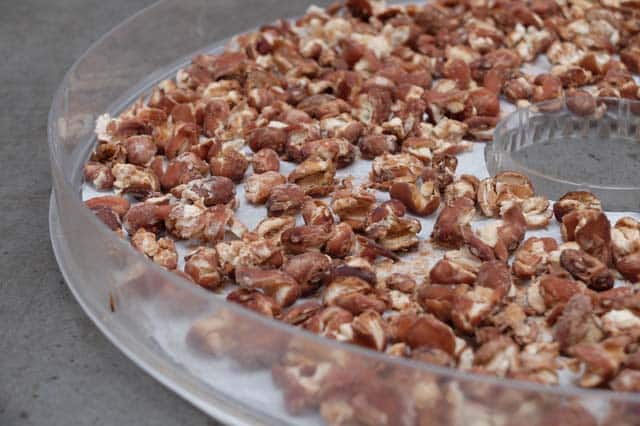
Dehydrated beans to go into backpacking meals
Protein is the building block of our muscles. It also has many other roles (which often get overlooked), such as regulating hormones, immune function, and enzyme reactions. When you run out of energy from carbs and fats (which hopefully won’t happen!), proteins can also be used for fuel.
Your body absolutely needs protein to help heal muscles. Backpacking causes a lot of strain on muscles and you will want to speed up healing – especially on longer backpacking trips.
Most backpacking meals – at least the freeze-dried meals by major brands – are lacking in protein. The Beef Stew made Mountain House has 13g of protein and their Pad Thai (vegan) has 20g of protein. The Chicken Vindaloo by Backpacker’s Bistro also has 13g of protein per serving (though just 290 calories so you’ll probably be eating 2 servings).
As a general rule, you need 0.8-1 gram of protein for each kilo of body weight. If you are doing high-intensity hiking, you might need up to 1.5g/kg.
For a small women like myself, that means about 50 grams of protein per day. For a large man, it means about 80 grams of protein. (10, 11, 12).
You can use this protein intake calculator to get an idea of how much protein you need per day. Choose the “maintence” as your goal and “intense” for activity level.
*See a list of the best backpacking meal brands here.
Note about Complete Proteins:
Proteins are made up of amino acids. There are 20 different types of amino acids that our bodies can only get from food. These are called essential amino acids. A complete protein is one which contains all 20 essential amino acids.
As a vegan, I’ve been warned that my proteins are “not complete” – meaning that they are lacking at least one of these 20 amino acids.
Yes, it is true that most plant-based foods are not complete (quinoa, hemp, and soy are some exceptions). But there is no rule that you need to eat all the amino acids in the same sitting. The amino acid lacking in one protein is likely to be found in another protein. So long as you eat a variety of protein sources throughout the day, you will be able to get all the amino acids you need. If you are really worried about amino acids though, incorporate hemp protein powder or other complete protein powders into your meals.
*See a list of vegan freeze-dried backpacking meals here.
Ratio of Macronutrients
The key to fueling your body during a long backpacking trip (especially an intense thru-hiking trip) is to get the right balance of carbs, fats, and proteins.
There is some conflicting advice about these ratios, but the recommendations generally fall under these ratios:
- Carbs: 35-50% of calories from carbs
- Fats: 35-50% of calories from fats
- Proteins: 15-20% of calories from proteins
Note that a military report recommends different recommendations for soldiers on deployment: 66% of calories from carbs, 21% from fat, and 12% from protein. However, this is likely because the soldiers are doing higher-intensity activities and need more glycogen from carbs. (13)
3. Junk Food and the Snickers Diet
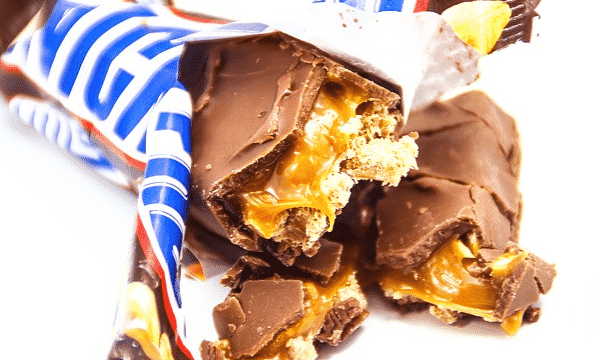
Brian Robinson has the record for completing the Triple Crown of Hiking (over 7,000 miles) in less than a year. He consumed three Snickers bars a day while doing it. (14)
Robinson isn’t alone. Many backpackers subsist on mostly candy cars during the day and maybe eat a hot dinner at night.
Yes, junk foods are loaded with calories. But, when planning your meals, it is important to know that these calories are from simple carbs and not from complex carbs.
- Simple carbs (such as refined sugar): These get converted into glucose very quickly, giving your body an energy rush.
- Complex carbs (like whole grains): These carbs take longer to convert into glucose, thus giving you more sustained energy instead of a spike.
In one sense, eating a lot of refined carbs on the trail is a terrible idea. As one backpacker put it,
“Eating refined carbohydrates is like trying to keep a bonfire going all night with newspaper.”
This is what happens when you eat refined sugars:
- Your blood sugar spikes.
- You quickly use up that energy.
- Now your blood sugar drops very quickly.
- Low blood sugar causes you to crash, leaving you tired, hungry, and grumpy.
Because of this, it is much better to snack on complex carbs while hiking. You won’t crash and burn.
However, those refined sugars can be useful as a quick source of energy. What’s important is that you don’t let your blood sugar crash while hiking. So, you’ll need to continuously snack if you are eating refined sugars – maybe as often as every 10-15 minutes!
I personally find that I eat much less when I consume complex carbs while hiking. I can go longer between snacks. Since the calories are being used efficiently, I can get away with bringing less food (and thus less weight in my pack).
This goes back to what I said about the problems with calorie counts. Our bodies don’t burn calories in a furnace and utilize every calories released from the food. Six teaspoons of refined sugar may have the same calories as one apple – but the apple is going to fuel me better and longer than if I guzzled sugar packets on the trail! And a dehydrated apple doesn’t even weigh that much. 🙂
As far as Snickers go, they might actually be the “ideal” junk food for backpacpking. That’s because they contain a great ratio of carbs to fat. The carbs refuel your muscles. The fat gets burned as energy while hiking.
Important note: Both protein and fiber slow down how quickly glucose gets into your blood stream. So, if you eat your refined sugar with protein (like chocolate-covered nuts), then you won’t experience such a big spike-and-crash.
4. Micronutrients
If you are just going on a short backpacking trip, then you probably don’t need to worry about micronutrients in your meals.
On longer trips though, lack of micronutrients could result in many problems like fatigue and muscle wasting. These problems can occur even if you are getting enough calories.
Dr. Brenda Braaten, one of the only experts on backpacking nutrition, blames this on digestive enzyme loss.
Digestive Enzyme Loss
Digestive enzymes are what we use to break down food. Without digestive enzymes, food just goes through our bodies without any of the nutrients being released. You could eat 6000 calories a day and still end up hungry and undernourished because the body isn’t getting nutrients from the food.
What causes digestive enzyme loss? Dr. Braaten blames the monotone diet that most thru-hikers have.
After a while of eating the same foods, the body stops making digestive enzymes required for breaking down other types of foods. For example, consuming too many carbs could cause the body to stop making enzymes needed to break down fat.
Nutrient Loss in Backpacking Foods
Another cause of fatigue and wasting on the trail is that the food simply doesn’t contain many nutrients. It isn’t that the foods didn’t ever contain nutrients. Rather, certain nutrients (particularly vitamins like vitamin C, A, and B vitamins) are very sensitive to oxidation (air), light, and heat.
It isn’t that the foods didn’t ever contain nutrients. Rather, certain nutrients (particularly vitamins like vitamin C, A, and B vitamins) are very sensitive to oxidation (air), light, and heat.
For example, fresh banana are rich in vitamin C and B6. But these vitamins can be destroyed by heat during the dehydrating process. Exposure to oxygen and heat on the trail can destroy what’s left of the vitamins. Cooking will also destroy nutrients.
How much nutrition is lost during dehydrating? Many fruits can lose 6% of their vitamin A, 55% of thiamin, 10% of niacin, and 56% of vitamin C. Dehydrating on a lower temperature can prevent vitamin loss.
Why is this worrying? Micronutrients are important for functions like immunity and rebuilding tissues. On top of that, micronutrients also help digest macronutrients. So, without micronutrients, your body won’t be able to release all of those calories you packed!
Here are some of the key micronutrients that backpackers should worry about:
- Vitamin C: Without enough vitamin C, thru-hikers can experience poor immunity, nose bleeds, and damage to connective tissue. Since vitamin C is important for repairing tissues, inadequate vitamin C can mean aching, swollen muscles.
- B Vitamins: These are crucial for energy production and metabolism, as well as the nervous system. Don’t get enough B vitamins and you’ll feel sluggish and make poor decisions.
- Calcium: Inadequate calcium may be the cause of cramps when hiking. Luckily, minerals like calcium are mostly preserved during dehydrating. You also don’t lose much calcium during cooking.
- Iron: Your body needs extra iron while backpacking to keep up with increased oxygen demands. For women in particular iron deficiency can be a big problem. Dehydrating and cooking don’t affect iron in food much. This is why I add dehydrated kale (a great source of iron) to my meals.
Solutions for Getting Micronutrients:
- Add lots of dehydrated fruits and veggies to meals: Dehydrating doesn’t affect minerals much, but it will reduce the amounts of vitamins in foods. However, some vitamins are better than no vitamins! So add lots of fruits and veggies to your meals instead of just focusing on carbs, proteins, and fats.
- Dehydrate at a lower temperature: As a general rule, dehydrate fruits and veggies at no higher than 120F/50C. This will preserve more nutrients.
- Eat tons of salad whenever you get to town: Instead of just eating a massive stack of pancakes when you come into town, order a salad. A BIG salad. Or just grab a bag of greens and some carrots in the local shop. Then munch on them in the parking lot. 🙂
- Forage: This goes against “Leave No Trace.” However, in many areas where there isn’t much foot traffic, it is perfectly acceptable to forage foods. I love adding fresh berries (a great source of vitamin C) to our morning oatmeal. Stinging nettles can also be found growing in abundance in many areas, which is very rich in iron, calcium, vitamin A, magnesium, and some B vitamins. Just put your stuff sack over your hands while picking it so you don’t get stung!
- Bring a multi-vitamin: Yes, this is absolutely worth the extra weight! You could also bring a quality superfood powder.
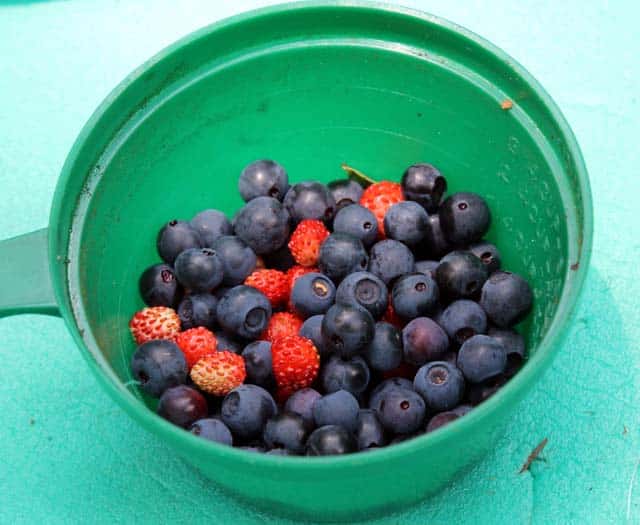
Foraged berriees are a great source of vitamin C
5. When to Eat
A lot of backpackers follow the same nutritional tactics that marathon racers use. They carb load before hitting the trail. Whenever they get into town, they also load up on carbs – often trying to eat what seems like a week’s worth of food in one sitting. They think this will make up for the calorie deficiency they purposely brought on the trail in order to cut back weight.
But backpacking is not like running a marathon! As talked about before, marathons are high intensity activities. The body uses large amounts of glycogen (from carbs) for fuel.
If you want to keep energy levels high while backpacking, you need to follow these rules:
- Snack constantly while hiking: You need a steady stream of carbohydrates coming into your body. This will allow your blood sugar levels to remain high enough so you don’t deplete glycogen stores.
- Eat a meal within 30 minutes of going to bed: You need a full meal after you’ve stopped hiking for the day. This meal will restock the glycogen stores so you have energy for the next day.
- Make sure this last meal has lots of protein: This will help your muscles heal faster.
- Don’t eat too much fat for breakfast or while hiking: It can take 6 hours for your body to turn fat into energy. Avoid eating too much fat before/during active times or your body will have trouble digesting it, causing you to feel nauseous.
Want healthier backpacking food? Get my eBook.
The book contains over 50 healthy, lightweight, and calorie-dense recipes for backpacking. Plus there is tons of info on planning backpacking meals. Since you made it to the end of this post, I’ll even give you a discount. 🙂 Get my eBook here for 50% off!
What nutritious foods do you bring when backpacking? Let us know in the comments!
Title image credit: “Trail Kitchen” (CC BY 2.0) by BaronBrian


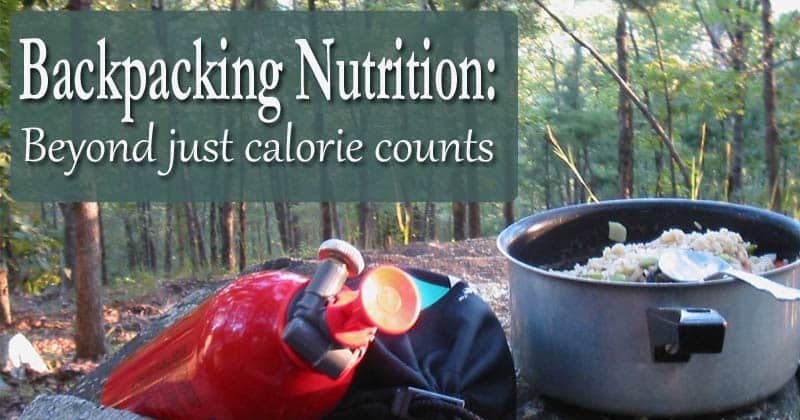
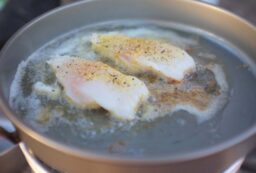
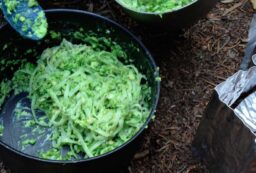
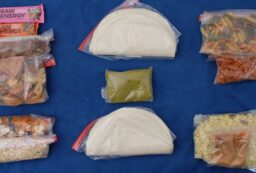







1 Comment
Lorna
July 17, 2022 at 4:36 pmExcellent article with really useful nutrition tips and facts, thanks for taking the time to share your knowledge!